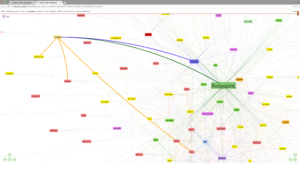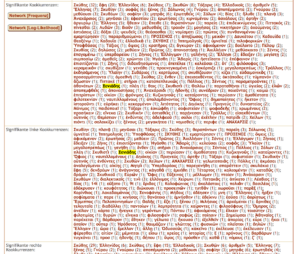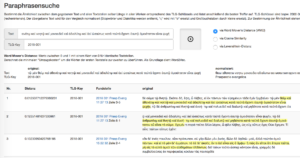1. Introduction: Text and Author: What’s in the data?
or:
or:
or:
For centuries scholars have been assembling collections of fragments from this kind of information about authors B, C, D, and also the unspecified group “many.”
It leads us down a different path than the philological-hermeneutical approach of the usual school of history whose approach is tied to the traditional concept of the author, i.e., always postulating an identifiable connection between author and text.
2. Examples
2.1 eAQUA





Primarily, Gorgias refers to visible things leading mankind astray and the ostensibility of the specified objectivity of factuality (Schubert 2007). Protagoras and Xenophanes too were famous for such positions:
Encountering the nomadic Anacharsis in this context is a stunning fact, as he was indeed known as a wise man in the tradition (see above), but not as a philosopher who might have engaged in the argumentations of epistemology. Instead, Sextus Empiricus extensively cites Anacharsis’ philosophical ideas: [26]



The lower significance value arises from the frequency in the entire corpus. This turns out to be 325 times higher with σποράδην than with νομάδας (value of 76). Accordingly, the algorithm evaluates the co-occurrence as three times more likely if the overall frequency (freq) is lower.
| Overall frequency | lgl | number | |
| νομάδας | 76 | 34,38 | 3 |
| σποράδην | 325 | 25,51 | 3 |
| μετανεστάκασιν | 3 | 59,56 | 3 |
| Φιλοχορος | 576 | 820,08 | 60 |
| Ἀνδροτίων | 252 | 806,92 | 53 |
In his book entitled Radiant Textuality, Jerome McGann establishes the view that texts are n-dimensional in every medium, especially in contrast to the copy-text theory and its emphasis on editorial decision. Accordingly, an approach that is based on this model of intertextuality, i.e., the relation of the texts to and among each other without the intentions of an author or editor intervening, would be much closer to the text—without the interference of editors.
2.2. Digital Plato: [35]
shows this result:

is the same as the input passage from Plato and a verbal citation (in Eusebius Praeparatio Evangelica 11.27.13).
the algorithm finds an even higher level a connection between Eusebius and Plato. The hit shows a passage in Eusebius Praeparatio Evangelica that cites Plotin, who is traditionally identified as the founder of Neoplatonism and who cites Plato’s Phaidon in his work Enneads. This Eusebius passage cites Plotin IV 7.6, in which he cites the text from Plato’s Phaidon!
3. Conclusion
Bibliography
Footnotes
[ back ] 32. FGrHist 328,F.2a (= Stephanus, “Ethnica” p.292 Billerbeck):
This is also handed down in the “Etymologicum Magnum” that has been apparently extracted from a work of Oros ‘On Peoples’.
